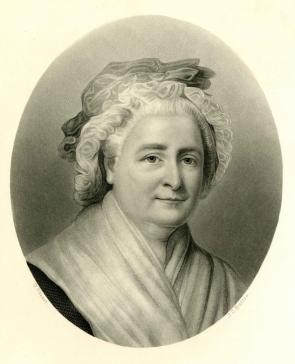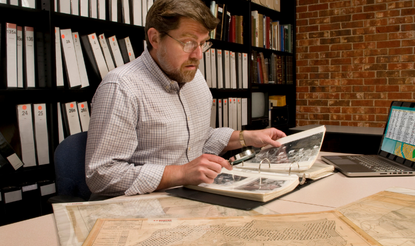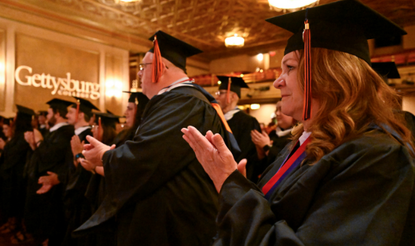Martha Washington Creates the Role of First Lady
by Patricia Brady
 During nearly forty-one years of marriage, Martha and George Washington lived together in harmony and mutual enjoyment. Never did he play the overbearing patriarch nor she the querulous nag. Theirs was a peaceful domestic partnership, surrounded by family and friends. Even when Washington accepted the command of the Continental Army without consulting his wife, she supported his decision and came to his side at Army headquarters every winter of the Revolution.
During nearly forty-one years of marriage, Martha and George Washington lived together in harmony and mutual enjoyment. Never did he play the overbearing patriarch nor she the querulous nag. Theirs was a peaceful domestic partnership, surrounded by family and friends. Even when Washington accepted the command of the Continental Army without consulting his wife, she supported his decision and came to his side at Army headquarters every winter of the Revolution.
But when, after much soul-searching, Washington agreed to have his name put forward for election as the first President of the United States under the new Constitution, it was another matter. She opposed him every step of the way. Although public opinion held that only George Washington could be trusted not to abuse presidential power, Martha believed that the nation should find another, younger man to sacrifice himself to public service.
The Washingtons had given up eight years of their lives to the American Revolution, returning home to a plantation in sad disarray. By 1788 Mount Vernon was again prosperous, and they had the time to enjoy themselves, as well as their adopted children—grandchildren from her first marriage, Nelly and Wash Custis. In her opinion "it was much too late for him to go into publick life again"; she had expected them to "grow old in solitude and tranquility together."[1] She begrudged giving up their quiet life and feared for the health of her fifty-seven-year-old husband, considered rather elderly in those days.
Despite her opposition, he bowed to his sense of duty and was unanimously elected president. On April 16, 1789, he set off for New York City, the nation’s temporary capital, for his inauguration. But she dragged her feet, refusing to accompany him because she claimed to need more time to get herself, the children, the servants, and all their supplies organized for a long absence from home.
For George Washington, a man who savored his "domestic enjoyments," the rented presidential mansion was not a home without his wife. We don’t know if he wrote asking her to hasten her journey because nearly all the Washingtons’ personal correspondence was destroyed after his death. Certainly his secretary wrote to the manager at Mount Vernon, one of Washington’s nephews, begging him to rush Mrs. Washington’s departure because "we are extremely desirous of seeing her here."[2]
In the month that she remained at home in Virginia, Washington and his advisors set about creating the new executive and judicial branches of the federal government. The Constitution provided the framework, but every day-to-day detail had to be worked out, every decision creating a precedent for the nation’s future. Even the social life of the President and his lady had to be considered. The only models the founders knew well were the glittering courts of Great Britain and France, not at all what they wished for. The United States was the world’s only modern republic; everything must be decided anew.
In Martha’s absence, Washington consulted Vice President John Adams and his Cabinet members about the form their social life should take. They reached the conclusion that any social activity relating to the president or his wife should be considered an official duty. They all agreed that neither of them should return social calls nor accept invitations to private events, such as teas, dinners, balls, or receptions. Furthermore, all invitations to the presidential mansion should be official as well, formal entertainments on set days. George Washington was already feeling the burden of dozens of unwanted callers who believed that any American citizen had the right to drop in on the President whenever he wished. In self-defense, the President began to host weekly public levees for gentlemen. No invitations were issued; any decently dressed man was admitted. Limiting access to publicly announced times was the only way Washington could see to do his job, and he apparently assumed that his wife would also find such a schedule pleasing. Again, we don’t know with certainty whether he wrote to consult her about the new rules, but it seems he did not because she was highly indignant when they were spelled out on her arrival in New York City on May 27, 1789.
An experienced and charming hostess, Martha Washington never imagined that her role in the new government would be hedged about with stringent dos and don’ts. As the commanding general’s lady during the Revolution, she had received and entertained many official visitors—congressmen inspecting the army camps, foreign nobility both hereditary and self-created, and high-ranking American officers. However, she considered herself in effect a private hostess, receiving and visiting friends, relatives, and neighbors as she pleased.
Now she discovered that the boundaries set for her social life by her husband and his male advisors were not at all to her liking. It had already been announced that Mrs. Washington would preside at a weekly drawing room for ladies and gentlemen on Friday evenings. On the second day after her arrival in New York, she was the hostess at the first of these receptions, which continued throughout eight years of her husband’s presidency. The President’s aides greeted visitors and escorted them to the drawing room. Seated on a sofa, she received her guests, who were then greeted by the President; afterward they were free to circulate among the other callers. Refreshments were light—wine, tea, lemonade, fruit, and cake.
As the wife of the Vice President, Abigail Adams generally was seated beside her on the sofa. Compared to European courts, these were plain affairs. Later on in the nineteenth century, romanticists liked to imagine these receptions as far more glamorous than they were. Both in prose and in printed illustrations, they portrayed a regal presidential couple standing on a dais to receive their guests. It was all nonsense: there was never a dais in any of the presidential residences, which were large houses that didn’t remotely resemble European palaces.
Also under Martha Washington’s purview were the formal dinner parties held each Thursday afternoon for government officials and members of Congress. The guests were invited in rotation, carefully chosen to balance one another by geographical area and political leanings, certainly not by social graces or friendship. George Washington’s idea was to bring together men of different persuasions, creating bonds between them. As a political theory, it made sense. As a social evening, it was often a fiasco. Everything about the government was still new and raw. The guests were predominantly male, seldom acquainted with one another, and often lacking basic social manners. Most had left their wives back home while they lived in boarding houses. Even Martha, accustomed as she was to masculine company in army camps, found conversation an uphill battle.
She also discovered the tedium of constant public attention. Contrary to her usual habit at home, her hair had to be set and dressed professionally every day, and she attended much more to her dress. She wrote ironically to a niece about the easily soiled white muslin dresses which she had begun to wear in the summer: "you would I fear think me a good deal in the fashion if you could but see me."[3]
Acting as the nation’s hostess has been an onerous task for many first ladies, but they have known what to expect. As the first president’s wife, however, Martha Washington had not foreseen the formality of official entertaining, nor that her own private life would be so curtailed. She was considerably disgruntled to find herself so fettered by political considerations. When Washington left for a tour of the northern states, she repined and stayed at home, declaring: "I never goe to the publick place—indeed I think I am more like a state prisoner than anything else, there is certain bounds set for me which I must not depart from—and as I can not doe as I like I am obstinate and stay at home a great deal."[4]
Although she happily occupied herself with the Custis children, she missed the daily company of adult women so common at Mount Vernon—numerous nieces from both sides of the family and her daughter-in-law. Fortunately, the wives of some of Washington’s Cabinet members were old friends from the Revolution—Elizabeth Hamilton, Lucy Knox, and Sarah Jay. An unexpected new friend, given the differences in their personal styles, was the tartly outspoken New Englander Abigail Adams. Generally inclined to critical observation, the Vice President’s wife wrote: "Mrs. Washington is one of those unassuming characters which create Love & Esteem. A most becoming pleasantness sits upon her countenance & an unaffected deportment which renders her the object of veneration and Respect."[5]
What a miserable legacy would have been left for succeeding first ladies if the men’s rules had been left in effect. But Martha Washington was not one to suffer when things could be improved. They left New York City for good in August 1790, staying at Mount Vernon for three months of much needed rest before returning to Philadelphia, the new (also temporary) capital in November. Her husband was brought to see that the initial decisions about their social life had been hasty and much too severe. As equal partners in their relationship, George Washington was unable to maintain these rules in the face of Martha’s unhappiness. Once in Philadelphia, the nation’s largest and most cultured city, the Washingtons started to lead a life of pleasure, actively enjoying their many friends in the city. Although they maintained their official schedule, they also accepted invitations from their friends and entertained them at home. The heavy burden of their official guests was leavened by the sociability and wit of their friends. Among their friends were the Powels, Binghams, Penns, Morrises, Reeds, and Allens—the most powerful families of the nation. Many doctrinaire Republicans were shocked by their being taken over by the wealthy and fashionable of Philadelphia.
Although Martha enjoyed their enhanced social life, Washington’s second term (accepted against her will) was a nightmare as opposing political parties began to form. The vicious newspaper attacks on her husband, the burden of eight years of public service, and the effects of a cold climate on her health made her eager to return to Virginia for good. She wrote just before leaving that "the curtain will fall on our public life, and place us in a more tranquil theater."[6] No one greeted at the presidential mansion by Martha Washington with her beautiful smile and warm hospitality could have guessed how unhappy she was in her position. Despite a very heavy cough and cold, she insisted that the family leave as soon as possible at the end of the second term. Remaining in Philadelphia long enough for Washington to attend the inauguration of John Adams in March 1797, they left for Mount Vernon in two groaning coaches packed with children, pets, aides, servants, and mountains of baggage. Much more was sent on by ship. And so they retired under their vine and their fig tree as promised in the Bible.
In the United States, former presidents do not retain that title; Washington, like Jackson, Grant, and Eisenhower, reverted to his military title and was addressed as "general" in his retirement. Mount Vernon became a shrine for visitors, continuing even after Washington’s death in 1799. The widowed Martha Washington was happy to welcome guests and talk about the founding of the nation. But for her that meant the Revolution, not the presidency.
[1] Joseph E. Fields, "Worthy Partner": The Papers of Martha Washington (Westport CT: Greenwood Press, 1994), 213, 223.
[2] The Papers of George Washington: Confederation Series, eds. W. W. Abbot and Dorothy Twohig (Charlottesville VA: University of Virginia Press, 1992), 1:388; The Papers of George Washington: Presidential Series, ed. Dorothy Twohig (Charlottesville VA: University of Virginia Press, 1987), 2:248–249.
[3] Fields, 217.
[4] Fields, 220.
[5] Stewart Mitchell, ed., New Letters of Abigail Adams, 1788–1801 (Boston: Houghton Mifflin, 1947), 13.
[6] Fields, 297.
Patricia Brady, Loyola University New Orleans, is a historian and the author of Martha Washington: An American Life (2005). Her most recent book is A Being So Gentle: The Frontier Love Story of Rachel and Andrew Jackson (2011).
Recommended Resources
Gilder Lehrman suggests Patricia Brady’s Martha Washington: An American Life (New York: Viking Penguin, 2005).
The author recommends the following resources:
Caroli, Betty. First Ladies: From Martha Washington to Michelle Obama. New York: Oxford University Press, 2010.
Fields, Joseph E., ed. "Worthy Partner": The Papers of Martha Washington. Westport CT: Greenwood Press, 1994.
Gould, Lewis L., ed. American First Ladies: Their Lives and Legacy, 2d. ed., New York: Routledge, 2001.
Lengel, Edward G., ed. A Companion to George Washington. New York: Wiley, 2012.
Schneider, Dorothy, and Carl J. Schneider, eds. First Ladies: A Biographical Dictionary, 3d. ed., New York: Infobase, 2010.
Watson, Robert P., ed. American First Ladies, 2d. ed. Ipswich MA: Salem Press, 2006.
Watson, Robert P., and Anthony J. Eksterowicz, eds. The Presidential Companion: Readings on the First Ladies, 2d. ed. Columbia: University of South Carolina Press, 2006.



